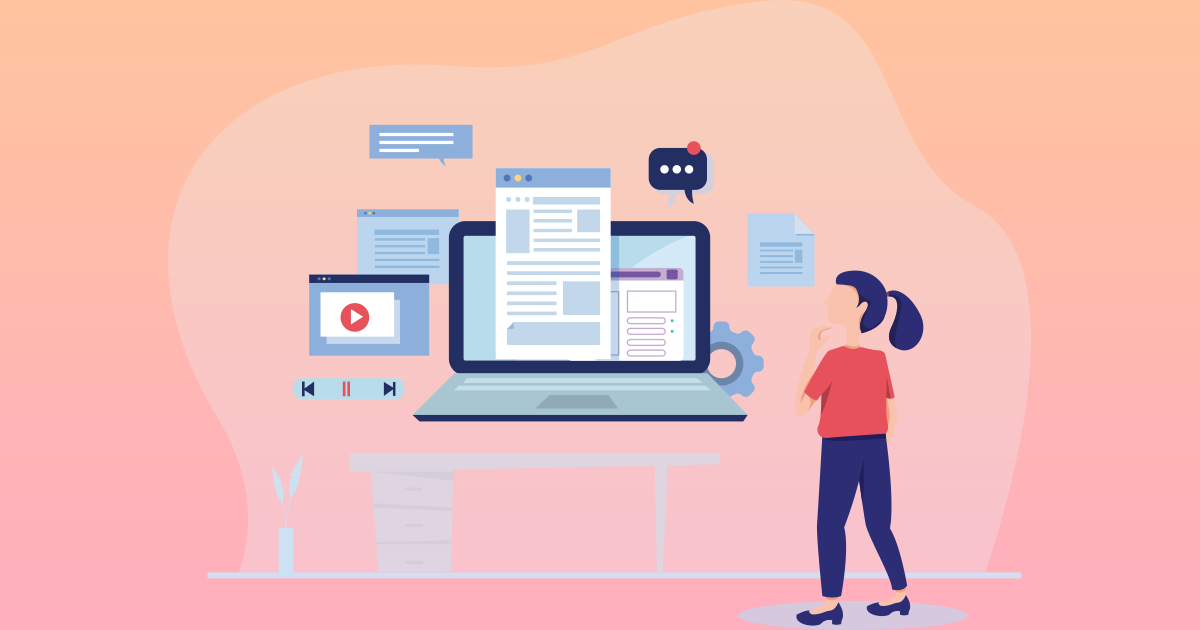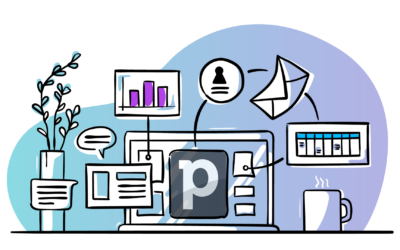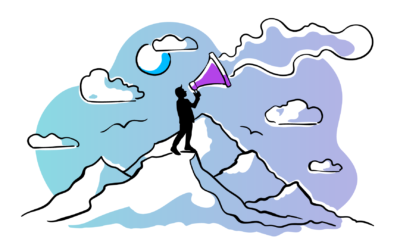Last updated: May 5, 2021
If you’re wondering what is a drip email campaign and how build one, I’m here to help.
Below, you’ll find a handy list of 12 drip email sequence triggers that you can use to move your leads closer to a sale and stay in touch with customers once they’ve converted.
For each trigger, I’ll share some pointers and email drip campaign best practices, as well as a handful of email drip campaign examples.
But first, let’s review the basics.
What is a drip email campaign?
We’ve consulted the Bane of University Lecturers (Wikipedia) regarding this, and found the following description for the drip marketing model:
Drip marketing is a communication strategy that sends, or “drips,” a pre-written set of messages to customers or prospects over time. These messages often take the form of email marketing, although other media can also be used.
Drip marketing is distinct from other database marketing in two ways: the timing of the messages follow a predetermined course; the messages are dripped in a series applicable to a specific behavior or status of the recipient. It is also typically automated.
So, according to Wikipedia, a drip email campaign:
- consists of pre-written messages,
- is user action or behavior based and
- is automated.
Drip campaigns are usually created for one of three main use cases.
What are the main use cases of drip marketing?
The three main use cases of automated email campaign drips are:
Onboarding emails or welcome sequences. So, let’s say someone signed up for your tool, service or list of subscribers. An onboarding or welcome drip campaign sequence will be helpful to initiate or welcome them, or show otherwise get them primed for more of what it is they signed up for.
Lead nurture emails. Drip lead nurturing campaigns have the primary goal of nudging the prospect to buy whatever it is you’re offering. This is most common in the B2B setting, and what exactly counts as a “lead” will depend upon your business. The main point in the context of drip email campaigns is that you have a list of people who are listening to you, but haven’t made a purchase. Your drip campaign’s goal will be to lead them to convert or abandon, with help from marketing automation.
Abandoned cart emails. These drip campaigns are a killer tool for direct-to-customer businesses, especially eCommerce. Most typically, when a subscriber meets the triggering criteria for an abandoned cart (e.g. they added a product to the shopping cart, but never checked out + 10 hours has passed), an automated abandoned cart email will be sent out. DTC brands recover some of such cases with drips that remind them to come back and complete the purchase.
A well set up drip email campaign will help you automate and scale your processes, whatever your use case. Done well, drip marketing campaigns will grow your revenues, while you’re mostly hands-off.
Sounds good?
Well, as with a lot of things, the idea itself is worthless. It’s the execution that matters. So, how do you actually integrate drip campaigns into your marketing strategy?
Onboarding email examples and cart abandonment drip campaign ideas have already been documented well elsewhere. So here, we’ll take a look at 12 potential triggers for drip campaigns, with a focus on lead nurturing email campaigns.
Nurture leads with triggered drip emailing
The most common drip email trigger is a newsletter subscription. But if that’s the only thing your using automated, trigger-based emails for… Well, you are missing out.
In fact, along with things like email drip campaign frequency and the content of your message, the right trigger can impact drip campaign effectiveness.
While, yes, signing up to a newsletter is the simplest way to trigger a drip email campaign, by being a little creative with your email automation and workflows, you can lubricate the lead nurture process, so you can guide the leads down your sales funnel and keep your existing customers happy.
<< Sign up to our free crash course on B2B email marketing >>
Here’s a rundown of my top email drip campaign ideas and email templates that you can start using today.
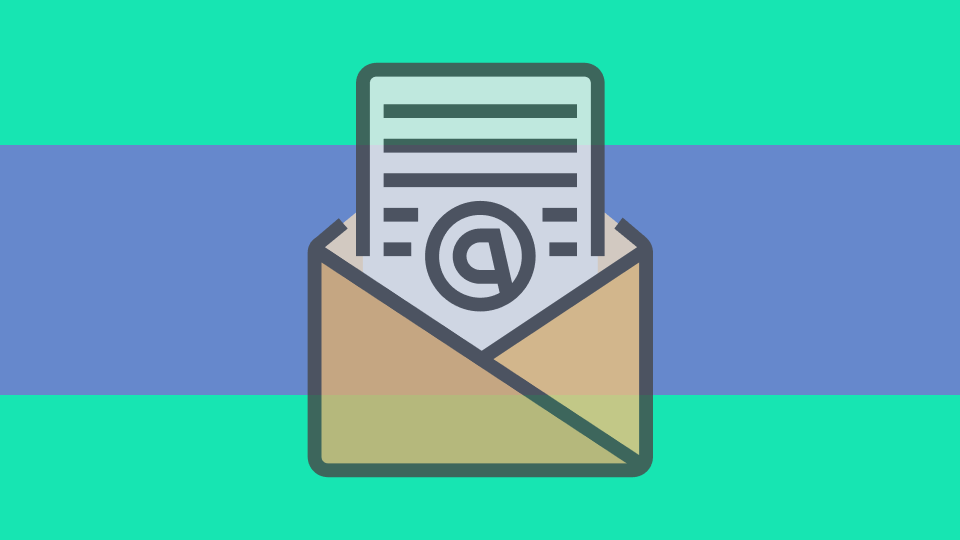
Drip email trigger #1: Signing up to a newsletter
Yes, yes.
I know I said using a newsletter as a trigger for a newsletter drip campaign is obvious (and if that’s the only trigger you’re using, maybe even a little bit lazy), but we all have to start somewhere.
Right?
So, what should you do once you’ve got someone to hand over their precious contact information?
Start with a warm welcome email, even if it’s just a confirmation
Sending a confirmation as the first email is kind of optional, but can really help if you’re struggling with hard bounces or very low engagement from your newsletter subscribers. The reason I say “kind of” is because in some parts of the world you have to be particularly careful about how you obtain permission to send marketing emails.
Thank them for subscribing
Not only is it common courtesy, but “thanks” is one of the most powerful words you can use in an email to customers or new subscribers. This is also a good time to drop in some personalized touches – but don’t expect to see a huge boost in performance just because you added their first name after the greeting.
Say who you are and what you’re about
I don’t buy into the whole “you don’t get a second chance to make a first impression” idea. Getting to know someone is a step-by-step process. And in my book, the welcome email is a second chance to tell them who you are and connect with them.
Highlight a few benefits, include a link to your very best content, tell them the story of how you ended up doing what you’re doing or share your mission.
Signing up to a newsletter: Drip campaign examples
The best email newsletter that is sent out daily (in our humble opinion), Morning Brew, welcomes you with a need to know, some steps to make sure their email deliverability is tip-top and a nice little nudge for you to share with friends.
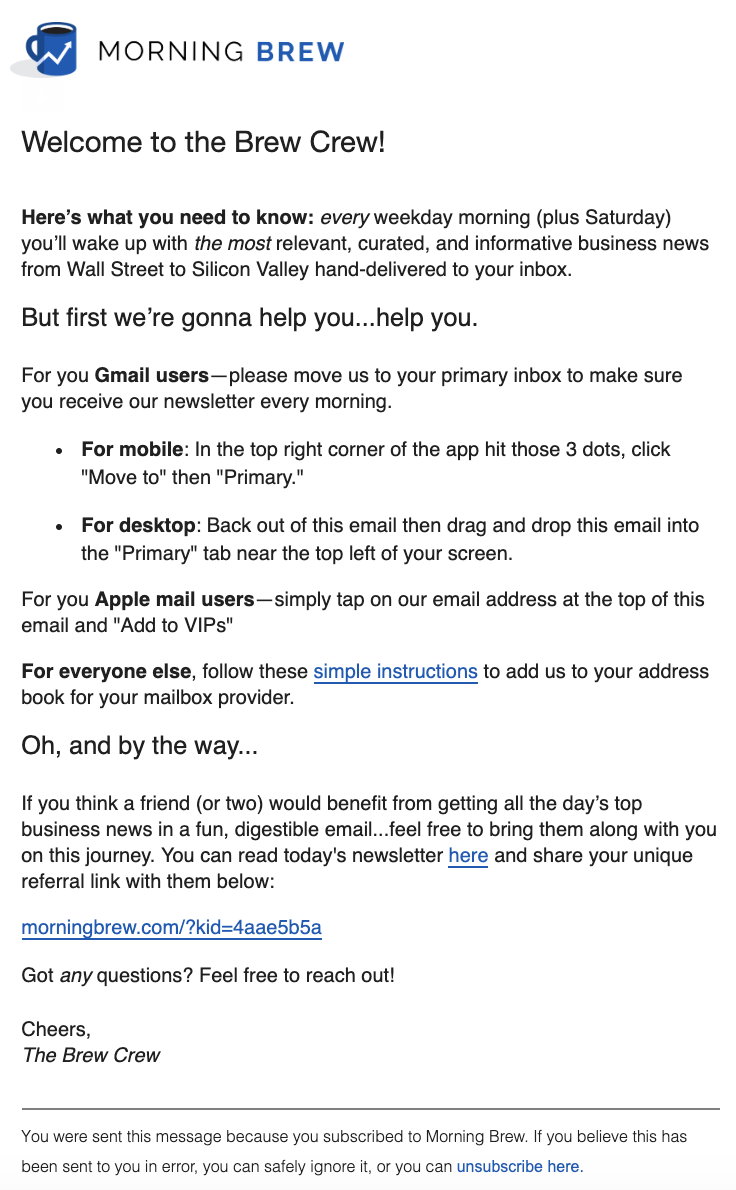
Purveyors of quality tech news, BizarroDevs, like to keep it safe with a tidy double opt-in approach, good for keeping bounce rates low and making sure you’re subscribers are not robots.
Here’s step 1…
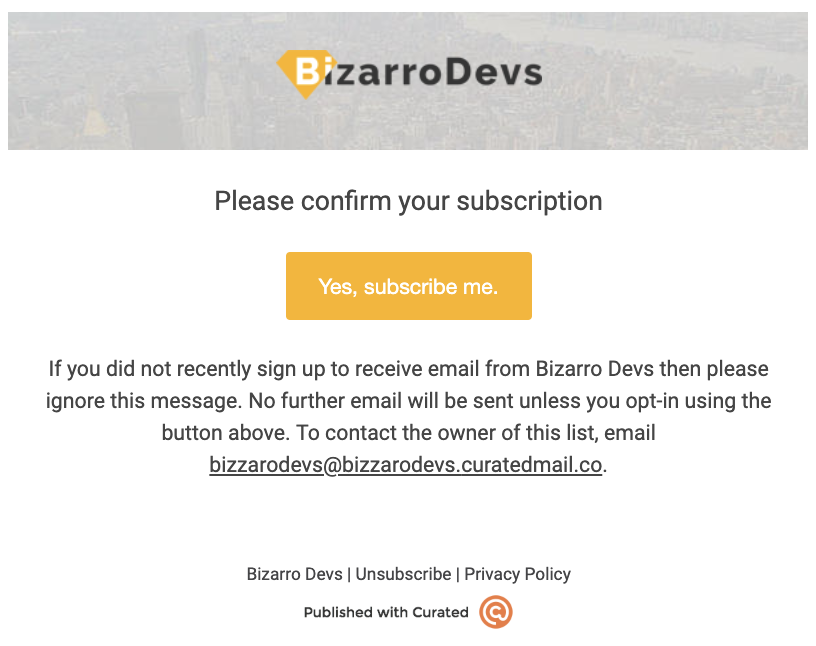
Then step 2 gives you a nice warm welcome and sets expectations for how often you’ll be getting emails from them as well as the content of the next newsletter.
Slick!

Trigger #2: Downloading an eBook or whitepaper
When “done right” eBooks, whitepapers, case studies and other content marketing collateral can be a vital part of an effective lead nurturing strategy. But again, as with newsletter sign-ups, the conversation shouldn’t end at the point of you sending them an email with the content.
Don’t just throw a book at them and walk away.
They’re engaged, they want to know what you have to say, so take the opportunity to keep talking.
Remind them what you’re sending
Consistency is key.
If someone wants your PDF eBook on “The 10 Most Hilarious Anecdotes of a Door-to-Door Widget Salesperson: 2020 Edition”, tell them that’s what you’ve sent. Say it in the subject line, the copy, and CTA. That’s the best way to assure a great conversion rate.
Oh, and make sure it’s accessible – a dead download link is never a good look. If you do catch a dead link after the email has been sent, always send an “oops” email, don’t just give up and move on.
Break it up
While your eBook drip campaign strategy might be to just keep sending them new, relevant eBooks and whitepapers every month, breaking up a single eBook over 5–10 days is a great way for both parties to get the best value from it.
Most people are too busy to sit there and trawl through pages of content. They’ll skim it and move on to the next thing. By breaking it up, you’re giving them a chance to digest all the most important morsels along the drip campaign timeline.
Essentially, you can take a single eBook and turn it into a fully-fledged educational drip campaign, including elegant upsell to whatever it is you’re selling.
Remind them to download
If you’re sharing a downloadable piece of content, it’s a good idea to track it so you can see who has (and who hasn’t) downloaded it. If they haven’t, then create a reminder telling them to download it and again, remind them what it is they’ve forgotten to download.
eBook or whitepaper: Drip campaign example
A nice, clean example from the folks at Intercom. A clear image showing what I’ve signed up for, and several (very tracked) links to download the eBook in various formats.
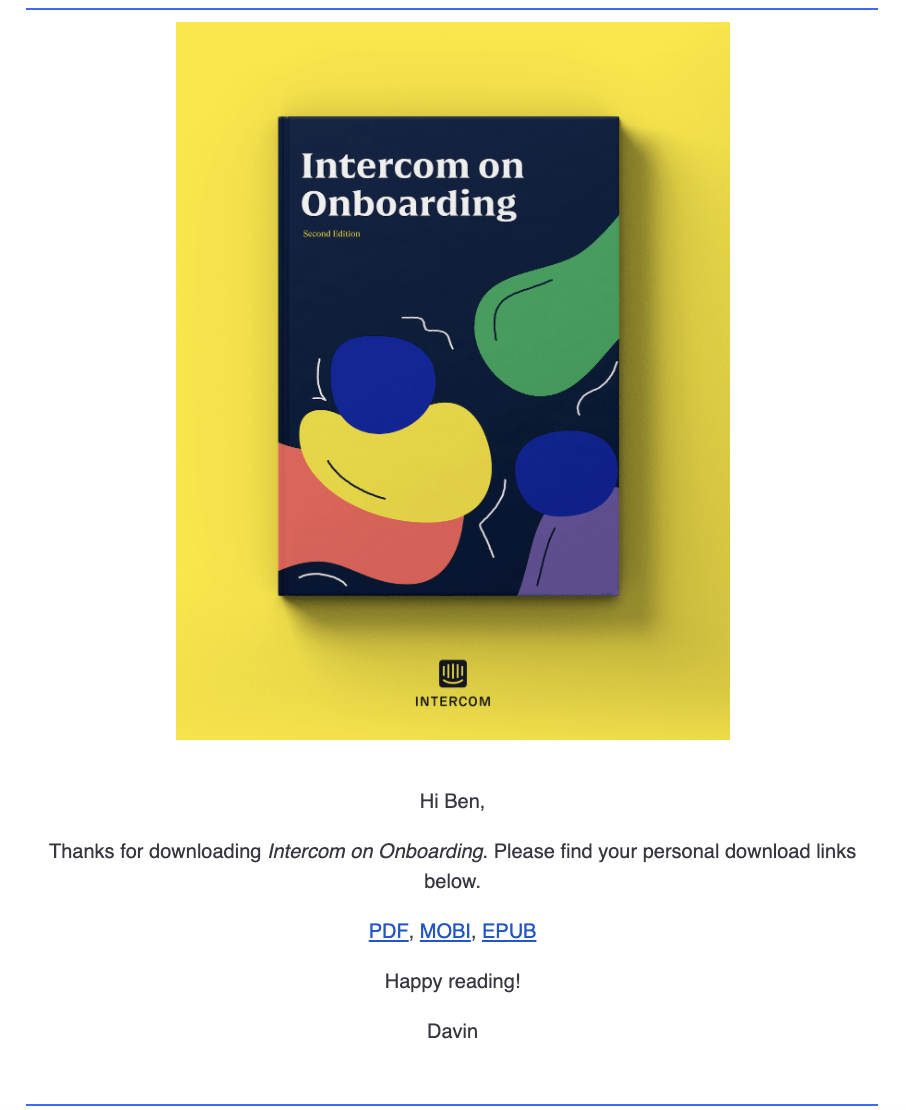

Trigger #3: Registering for a webinar
Webinars can be a killer tool for businesses and for some, they can be the leads’ entrypoint into the sales cycle. So, putting a webinar at the center of your email drip campaign strategy really makes a lot of sense. Yes, you could just send the standard “thanks for signing up” email, but you’d be missing a trick.
Send a follow-up if a lead visits, but doesn’t register
If you’re able to track and link web visits to your contacts, you can use this as a trigger to send out an invite. All you’ll need to do is wait a few hours, check whether or not they have registered in the meantime. If they haven’t registered, send them an invite.
Tell them what your webinar is about
Once they’ve registered for your webinar, follow up right away with a thank you email, plus:
- Time (and timezone)
- Duration
- Date
- How to access it
- Who’s going to be talking
- What they’ll be talking about
Make sure you’re talking about the content of the webinar in the context of what value you can give to your leads and customers.
I highly recommend looking at using a calendar link, so they can have the event added to their calendar automatically and be reminded. Speaking of reminders; your drip campaign timeline depends on when they signed up, but 3 reminders can work well: 14 days before, 5-7 days before, and 24 hours before.

Trigger #4 Attend (or missed) a webinar
So, once you’ve broadcast your webinar and the attendees have gone away having learned something new, what next? And what to do with all those people who signed up, but could make it or maybe left partway through?
Say “thanks” and ask for feedback
You should be saying thank you whether or not someone was able to attend: if they did make it, say “thanks for joining us”, if they didn’t say “thanks for your interest and we missed you”. Being warm and human goes a long way.
If they were able to attend, the follow-up email is also a good time to ask for some feedback or suggestions for future webinars. How was the audio quality? Did you learn something new?
Share a recording and questions
One of post-webinar drip campaign emails should include at least a link to the webinar recording, and that should go to all of the people who registered. Pro tip: segmentation will help make these emails more relevant. Just tweak the messaging a little for the different segments.
Another thing that I’ve done with post-webinar follow-ups is to type up and share any questions and answers that came up during the session. Initially, I did this all in one email: a link to the recording then a list of Q&As in the below it.
Then, later on, we created a landing page that had the video embedded, the Q&As and a registration form for the next webinar in the series.
Keep them in the loop about future webinars
Someone attending one of your webinars is a strong signal that they’re your target audience and that they’ll be keen to rock up for another one. Particularly if you’ve got some good feedback from them – you… you did ask for feedback? Right?
Capitalize on that strong signal. Keep them up to speed on future webinars and cross-sell to them by sending them invites – although don’t go the route of spamming them with notifications otherwise, you’ll quickly exhaust those positive vibes.
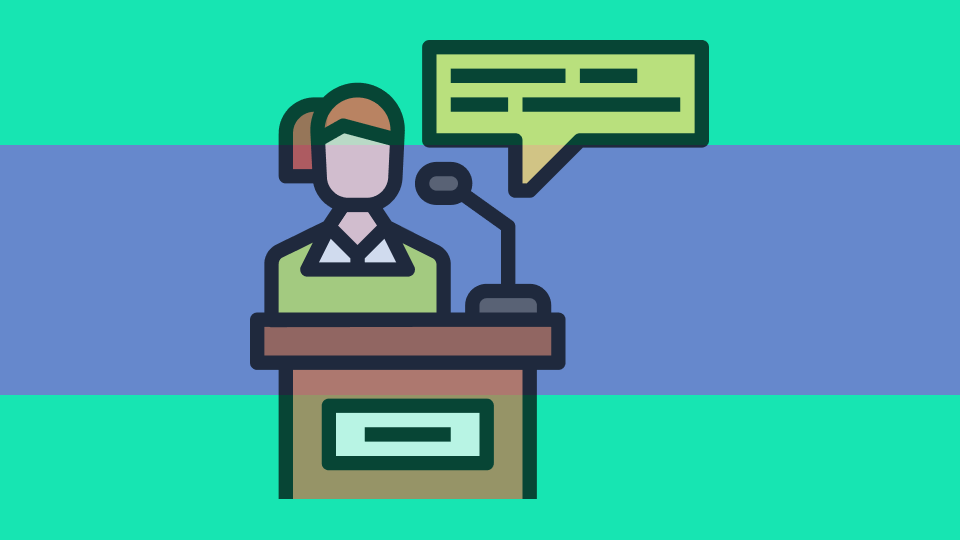
Trigger #5: Following up after events
Events can be a mixed bag when it comes to securing leads.
Often, after the chaos and exhaustion have worn off, it’s hard to remember who you spoke to. So, the leads that you do manage to get should be part of a lead nurturing process to reengage them after that all-important first meeting.
Introduce yourself and reengage
If you have a handful of business cards, making the personal connection via email (or Linkedin) post-event definitely works.
But if you’ve been on a roadshow and ended up with a fat stack of cards, you’re going to want to rely on some automation to make a dent.
Open up with an introduction, treat it almost like a cold email and don’t assume they remember anything about you. Try and remind them by mentioning what event you met. Give them a short and sweet summary: who you are and what benefit you can provide them. It’s the one thing great marketers do well: build relationships.
Your drip campaign timeline here really depends on so many variables.
For example, I am still receiving monthly follow-up emails from an IT services rep I met at an event 2 years ago. I don’t need his services at the moment, but you bet he’ll be the first guy I call when I do.

Trigger #6: Not interested, yet
Any salesperson should expect to be told “no”. The more no’s you get, the closer you are to a yes, after all, so being turned down is all part of the process. But it shouldn’t have to be the end.
Build up rapport
Being rejected by a prospect often means the relationship wasn’t ready for them to take the leap. And that is absolutely fine.
It’s a perfect example of where harmony between sales and marketing can work wonders. If you’ve had to move a few steps back up the pipeline, marketing can step back in with a lead nurturing process that warms them back up with relevant content.
A “no” doesn’t mean the end of the road. So long as one person in the equation sees value in pursuing a relationship, then it’s not over. It’s on them to convince the other that the offering meets that need, and build rapport.
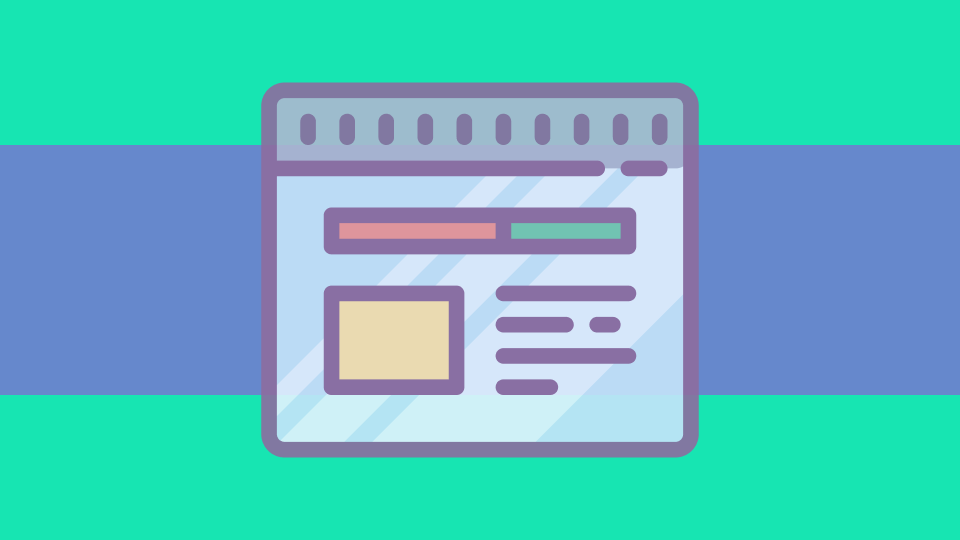
Trigger #7: Viewed a specific page on your website
Monitoring your visitors and leads with web visitor tracking is no longer some kind of marketing voodoo. It’s easy to set up, and if you make sure your web tracking tool logs data in your CRM, then your sales team will know which of your prospects are giving you a closer look.
Reinforce the benefits
If you can see they’ve viewed a page for a product or service that they offer, follow-up with something that really drives home the benefits of what they’ve just looked at. Break the benefits into digestible chunks, and then ask them if they want a demo of this particular thing.
Play with pricing
If you have a pricing page on your website, chances are it’s one of the most important and viewed pages on your entire site. If someone visits this page and then keeps looking at other pages, it’s pretty likely that they’ll be interested in parting with some cash.
Send a follow-up that outlines the benefits of a particular plan you offer, then if they don’t convert right away, send a follow-up offering them a discount on the price you shared, just to try and help them past the finish line.
Viewed a page: drip campaign example
Here’s a juicy example from the good folks over at Pipedrive: Whilst putting together this very article, I briefly viewed this page about sales lead generation on the Pipedrive blog.
Being a Pipedrive customer, they fired up their email big guns and sent me this to peruse at my leisure. Lovely stuff.
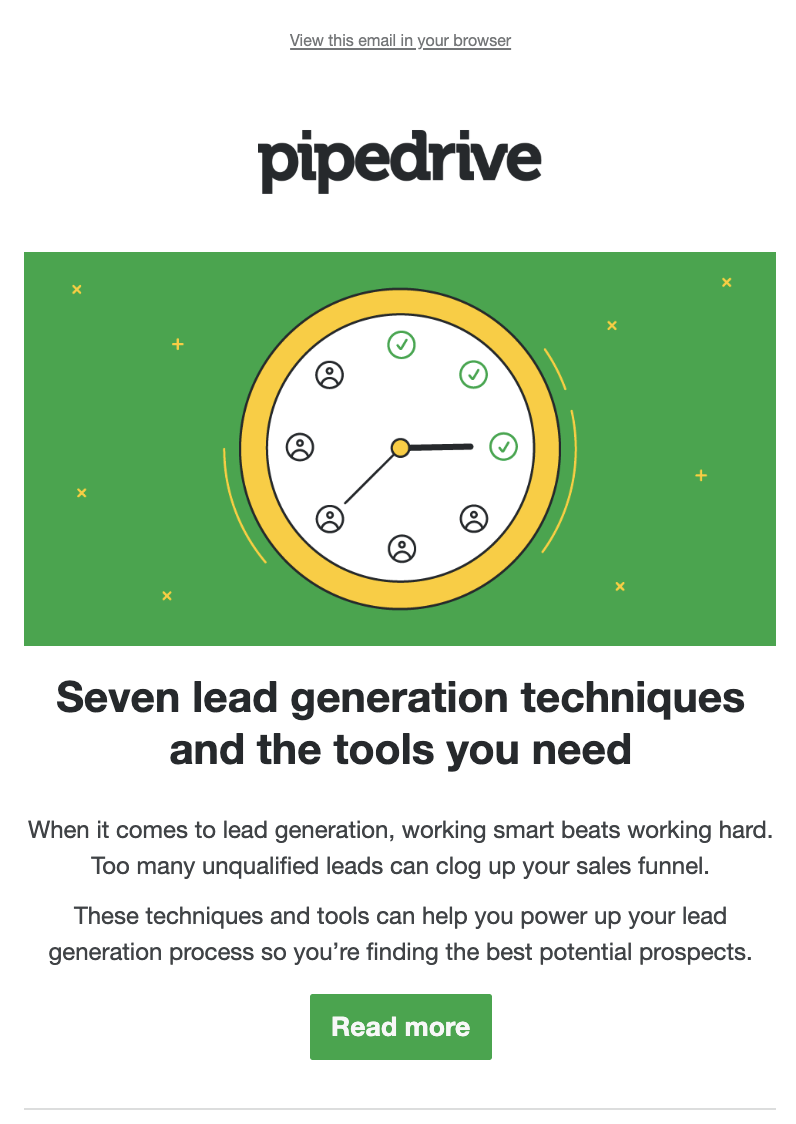
Onboarding new customers with drip email triggers
Congratulations! You’ve converted your lead into a customer. Time to kick back and let the money make itself. No. Not a bit. Now’s the time to make your drip campaign strategy work to keep on delighting them, now they’re a paying customer.
It is cheaper to retain or reactivate an existing customer than it is to get a new one, so if you’re going to pick a stage in the sales pipeline to focus all your love and attention, this is it.

Trigger #8: The welcome email
If you’re running a SaaS-type business, chances are you’re already using some sort of welcome email, for example when someone signs up for a free trial. But it’s not just software companies that can use this as an opportunity to engage customers.
If you’re selling widgets – physical or digital – sending a welcome email is a chance to present your brand and products. Agencies aren’t alone here, either. If you’ve automated your agency’s quotes, when a customer approves the quote, welcome them aboard and tell them what the next steps are.
Roll out the red carpet
Your welcome email needs to make the customer feel special and is a perfect time to work some creativity into your copy. Use some clever examples of how your product works, share your brand’s story and present your vision.
And don’t just leave it at “hello”. Check-in after a few days to see if they need a hand, ask them how they’re getting on or keep them up-to-date with the latest happenings. We’re also big fans of addressing key pain points with your onboarding emails, especially if your onboarding involves trial users.
Combine designed and plain emails
Everyone says that they prefer image-heavy, sexy emails, but, well the numbers say otherwise. There’s plenty of data that shows plain-text emails work better than designed emails. They feel more personal, more conversational.
That said, I totally understand the desire to use designed emails. They let you be more creative and showcase your brand’s visuals, which is important.
So, try A/B testing plain-text and designed messages to give both a professional and personal feeling. Then measure the click-through rates to see what works best for you. And only then look into optimization, based on results.
Welcome email: drip campaign example
The team at Segment, jump with joy when their customers connect. Bonus points for the animated gif. Nice.
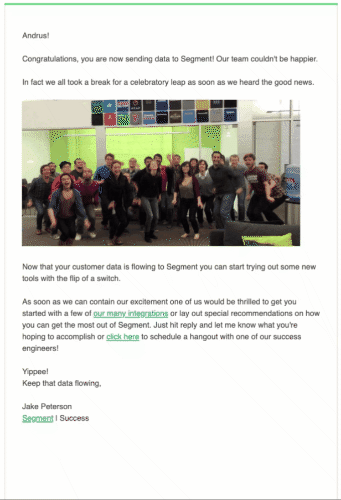
This example lays what the next steps are the new users, as well as offers them the chance to schedule a call with one of the team. It’s concise, friendly and lets you know there are people on the other end – all the things we’re fond of at Outfunnel.

Drip email trigger #9: High activity
Social proof is one of the most effective ways to build trust and if you’re able to identify your most engaged, active customers, automatically reaching out to regular customers and asking them for some positive feedback is a great way of taking the manual labor out of the process.
Ask them for a review
Your most active customers – be it SaaS users, regular purchasers or consistently agency clients – are prime candidates for providing you with some solid social proof. By sending out an automated email that asks a client to leave you a review on an app marketplace, crowdsource software review site or even social media you’ll be able to cultivate some public positivity in no time.
And it’s not just positive feedback you should be on the lookout for. Your most regular customers are also good candidates to survey as they’re more likely to provide honest, actionable feedback, plus it’s a good opportunity to sound out potential roadmap plans.
Invite them to your affiliate program
Time and again, affiliate and referral programs have helped some of the biggest names in tech blow up in a relatively short space of time.
And, yes, there’s certainly a case that every one of your customers should be invited to your affiliate program (hint: they should), using high activity as a signal to pay special attention to a specific segment makes more sense than potentially wasting your time on someone who’s used you only a handful of times.
High activity: drip campaign examples
The guys and girls behind social media automation tool MeetEdgar invite you to step inside their inner circle, the Edgar HQ Facebook group.

Another neat tip here is that each of the 2 main paragraphs repeats the link to the focus content. One at the beginning and one at the end. Personally, I like to focus on a single link, distributed 3-4 times throughout the email copy, but this can be just as effective.
Cross-platform integration specialists, Zapier, send out this perfect example of asking for a review. Zapier knows what integrations you’ve used and, when you do, sends a targeted, plain-text email, asking for a review.
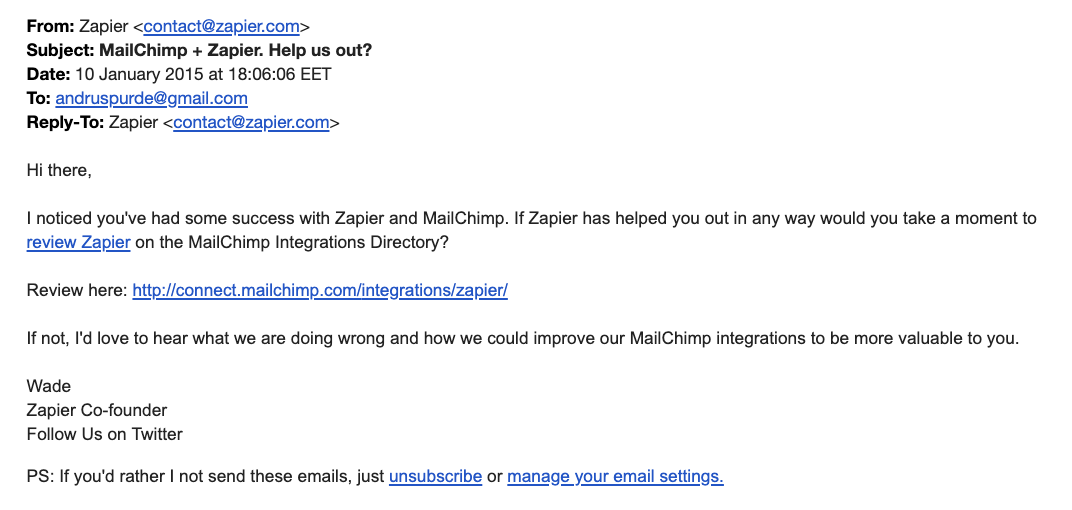
In this case, they can see you’ve used the Mailchimp integration and, you’ve guessed it, sends you a link asking you to leave a review on the Mailchimp Integrations Directory.

Drip Email Trigger #10: NPS or feedback score
While we’re on the subject of feedback, using the feedback itself to trigger an automated drip campaign of some sort is another way of both gather social proof and nipping potential problems in the bud.
And it’s not just the big boys that hunger for customer feedback. At Outfunnel, we send a “rate your experience” email whenever we support ticket has been closed.
Flag for follow-up
Negative feedback is a vital part of doing better in pretty much anything. What really matters though is how you respond to it. Using negative feedback as a trigger for an automated drip campaign is probably not the best way to go, but it should definitely be a trigger for action.
Using a neutral or negative score to trigger an automated follow-up is definitely a solid move. Ask your customers what you could do better or what they feel you’re missing and offer them the opportunity to speak to you directly, either on a call or by responding to an email.
NPS or similar feedback score metrics: drip campaign examples
Top tip: if you’re sending a survey, don’t send it from a noreply address. You’re literally asking for feedback after all.
In between Outfunnel and family, I’m a pretty avid gamer (feel free to hit me up in the comments if you want to connect on Steam, Xbox Live or wherever; always happy to meet a fellow gamer).
I get sent a lot of requests for feedback and the like, including one recently from Ubisoft.
Problem was, the survey was bugged on one of the questions, then, when I tried to report the issue by replying to the email, this is what I got back:
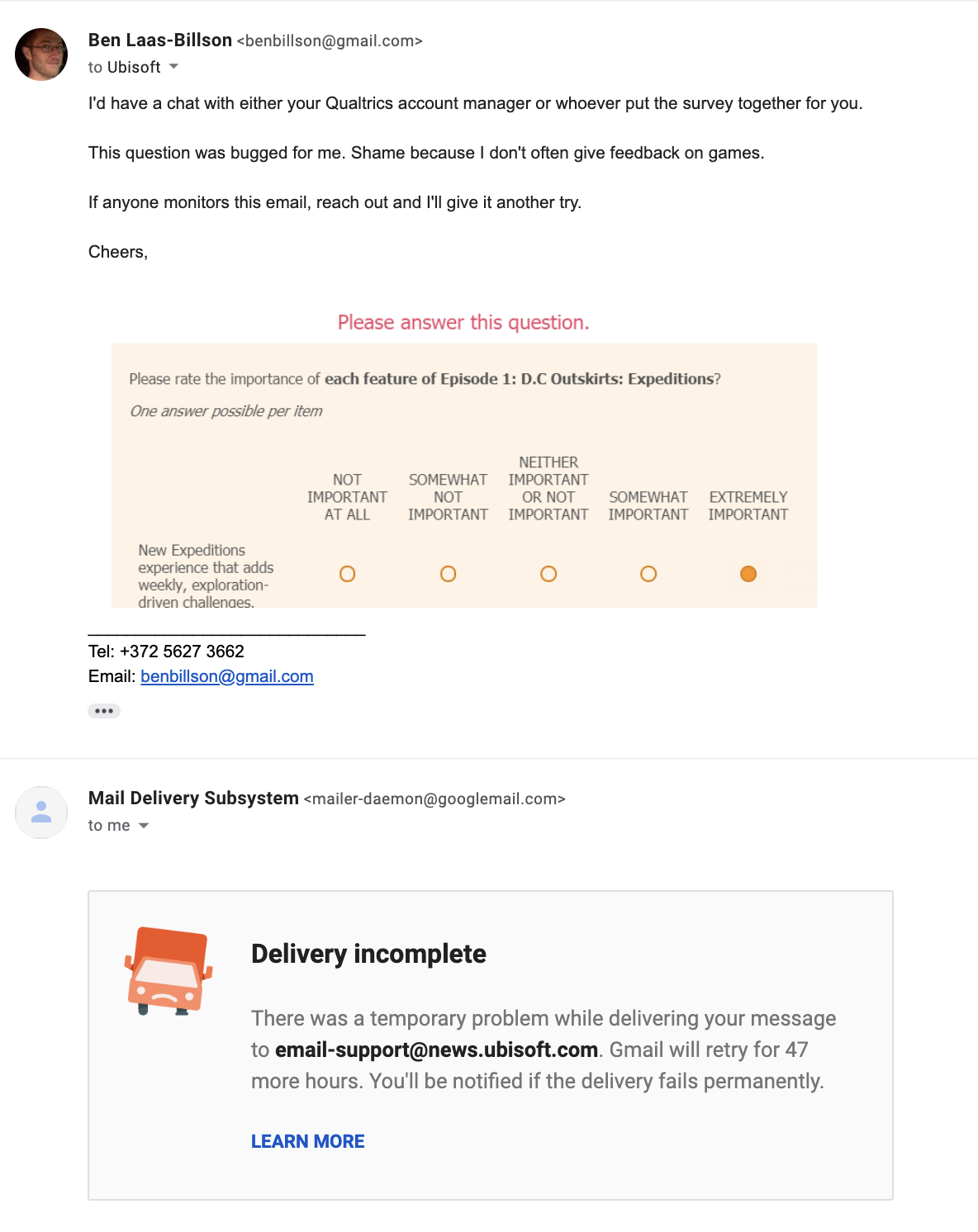
Not a great look.
Asking for feedback after a “bricks and mortar” store visit makes perfect sense and presents a great opportunity to gather actionable ideas.
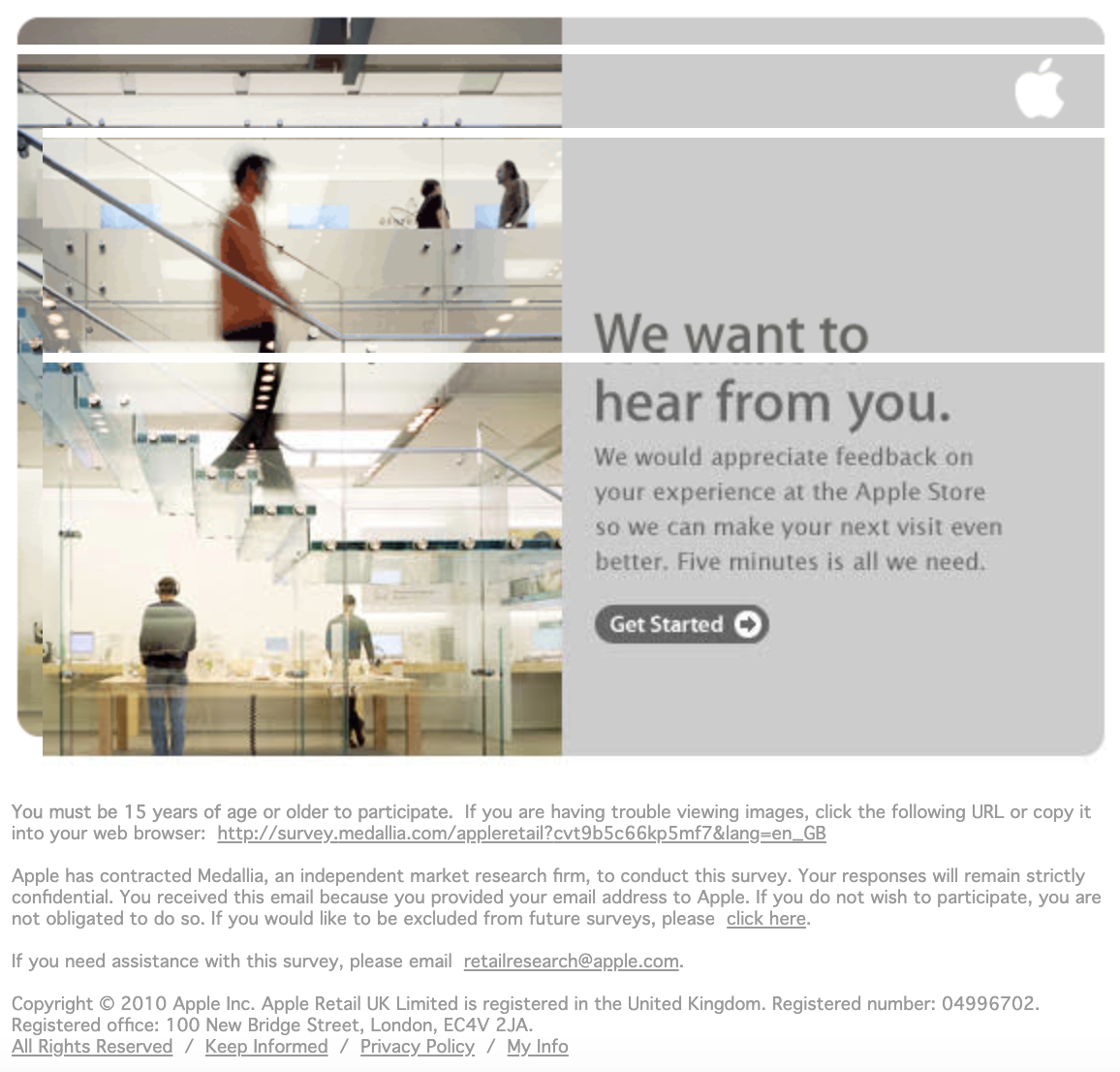
Ussing triggered drip email marketing to deal with churn
Like it or not, customer churn is an inescapable reality of business. You simply can’t win them all, all of the time.
Using churn as a trigger for automated campaigns means you can, scalably, reintroduce yourself to customers who’ve gone dark and, potentially, understand why they left once they bid you farewell.

Drip Email Trigger #11: A period of inactivity
If a customer goes dark, don’t despair. It could be seasonal inactivity, a common headache for both SaaS and agency businesses.
Or maybe they’ve straight-up forgotten about you?
Well, now’s the time to say “Hello, nice to meet you for the first time again”.
Jog their memory
First step is to remind them who you are and how you can help them. Once you’ve got the reintroduction out of the way, take some time to highlight a few things that they’ve missed in their absence.
Got new features? Tell your customers why they should care. Restructured your pricing? If you’re saving your customer some money, show them how much. All of this will help you stay top of mind.
Don’t overdo it and be ready to move on
I’m a firm believer that there’s no point in clinging on to zombie accounts.
So, after a few attempts to reactivate them, be ready to close their account. Constantly spamming customers who haven’t taken the time to hit “Unsubscribe”, pleading with them to come back wastes your time and increases the chances of you ending up getting marked as spam.
We live in a post-GDPR world, so be fully prepared to purge their information from your database and let them know that you’ve done so because you value their privacy and data security (you do, right?).
Inactivity: drip campaign example
This example from MindMeister leans heavily on a reactivation incentive, then finishes on a reminder of what you can do with MindMeister
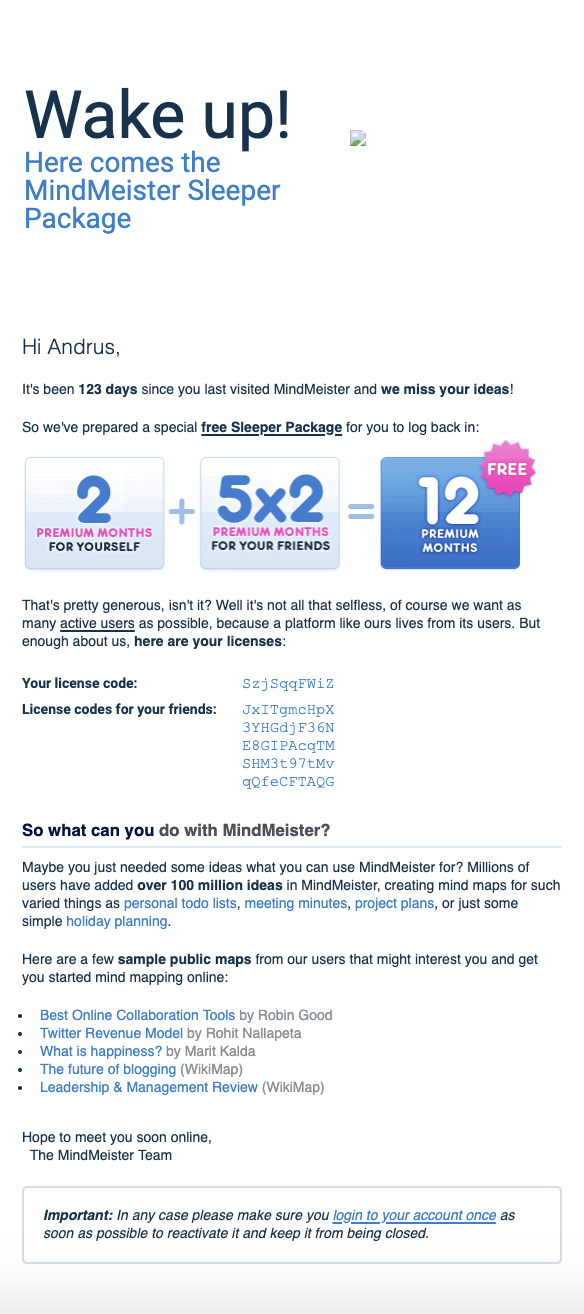

Drip email trigger #12: When they cancel their account, leave your platform or take their business elsewhere
Breaking up can be tough, but as in life, it’s an opportunity to learn something. An optimized exit survey can get you a response rate of around 10% so taking the time to craft your survey and ask the right questions is definitely worth it.
Be open-ended
In a past life, I worked for a large bank/credit card company and one of the first things we were taught was “never asked closed questions”. Asking a “closed” question gives the respondent the opportunity to say “no”.
By asking an open-ended question, like “Why did you leave?” is much more likely to get you a response than “Was there something we could have done better?” or a page of prefilled tick boxes.
Say goodbye
When you get the feedback you’re after, whether it’s viscerally tearing you to shreds or gently hinting that something might be amiss, thank them for it, it’s time to say goodbye. If they left because you’re missing a feature.
Goodbye: drip campaign example
Low open rates on your email lists are something that could prompt you to say goodbye. Here’s an example of a company being proactive when it comes to keeping their email list neat and tidy.
Framebridge noticed that their newsletters haven’t been opened for a while so, they took the step to preemptively say goodbye.
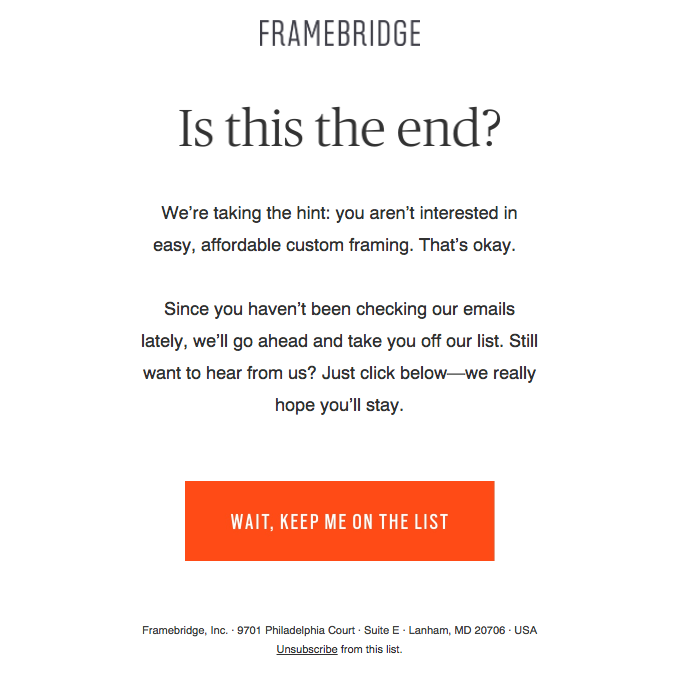
Testing out these drip email campaign triggers
Outfunnel already uses several of these triggers for our own automated email sequences.
But several is not enough. We’re always experimenting with different email triggers. We’re also experimenting with segmenting our audiences and email drip campaign frequency (we recommend reading up on it, as it’s one of those topics that’s often shrouded in confusion and misleading information).
Oh and if there any email drip campaign ideas or email drip campaign best practices that you think I’ve missed, be sure to let me know in the comments.
Pipedrive, Copper or HubSpot CRM customer? Make sure your drip emails are in sync with your CRM.
The Outfunnel vision is all about bringing sales and marketing closer together. Giving salespeople easier access to actionable info, and closing the feedback loop between the two disciplines.
With Outfunnel, you can:
- Connect your sales and marketing data, deeply and easily. For example, sync contact lists and share marketing engagement data automatically.
- Highlight sales-ready leads with Web tracking and Lead scoring.
- Use our simple email campaigns tool to create and send single and multi-stage email campaigns to recipients defined by your CRM filters.
Ready to try it out? Register for a 14-day Outfunnel trial, no credit card or other nonsense required.

